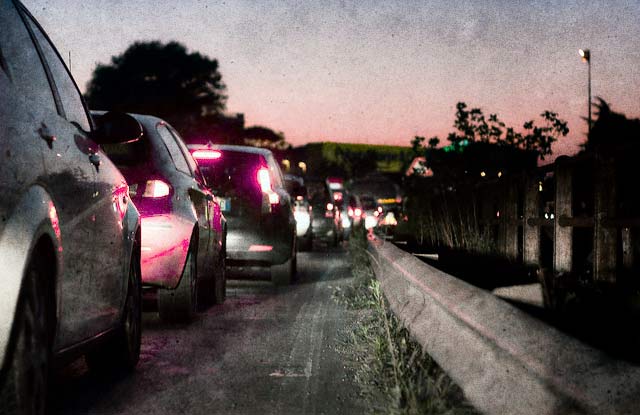
Stuck in standstill traffic in downtown Baltimore, I catch this message emblazoned across the side of a city bus: “Did you know? This bus operates in ‘zero emissions’ mode on battery power up to 40 percent of the time.”
Maybe I should be impressed or encouraged.
Instead, I realize, this bus in front of me is churning out something I don’t want to breathe at least 60 percent of the time. I’m suddenly aware that I’m sitting in a sea of exhaust.
I tap the switch to cut off the outdoor air circulation. I look at the other cars and trucks in the standstill. There’s no visible exhaust, but I’m not reassured — the most toxic forms of vehicle exhaust are often invisible.
Take benzene, a known carcinogen that’s added to gasoline and then expelled as exhaust into the air we breathe. Cars and trucks produce a variety of other emissions in the form of “particle pollution” that can penetrate past the filtering systems of our lungs and into our bloodstreams.
We’ve made a lot of progress in reducing overall air pollution in places like Baltimore by raising standards for smokestack emissions and adopting the vehicle emission limits known as “CAFE” standards.
But it’s not enough.
In 2013, the World Health Organization declared air pollution a human carcinogen that increases the risk for lung and bladder cancer. And when a Tufts Medical School team mapped heart attack rates in the Boston suburbs, they found the highest rates in communities located along the major transportation arteries.
Vehicle exhaust also contributes to ground-level ozone — better known as smog — that can blanket entire areas.
This smog contributes to breathing difficulties. When children play outside on a smoggy summer day, a spike in ground-level ozone can scar their lungs and mark the beginning of a lifelong struggle with asthma or other chronic conditions.
So air pollution is implicated in our cancer epidemics, the prevalence of heart disease, and the persistence of asthma as a serious health threat.
Burning fossil fuels is the problem.
It’s not only warming our climate, it’s polluting the air we breathe. We don’t hear enough about the connections between our vehicles, air pollution, and our health.
A recent MIT study estimated that air pollution kills over 200,000 people annually in the United States. And the largest number is attributable to emissions from vehicles.
Especially if you live next to highways, ports, or rail lines, the air you’re breathing is probably dangerous to your health.
Fortunately, we have alternatives to gasoline and diesel fuel. Electric vehicles — when charged with electricity from renewable sources like wind and solar — and mass transit can slash your transportation-related carbon footprint and cut down on particle pollution.
A bus that contributes to air pollution over half of the time doesn’t impress me. Let’s invest in a future where we can breathe clean air 100 percent of the time.
Thank you for reading Truthout. Before you leave, we must appeal for your support.
Truthout is unlike most news publications; we’re nonprofit, independent, and free of corporate funding. Because of this, we can publish the boldly honest journalism you see from us – stories about and by grassroots activists, reports from the frontlines of social movements, and unapologetic critiques of the systemic forces that shape all of our lives.
Monied interests prevent other publications from confronting the worst injustices in our world. But Truthout remains a haven for transformative journalism in pursuit of justice.
We simply cannot do this without support from our readers. At this time, we’re appealing to add 50 monthly donors in the next 2 days. If you can, please make a tax-deductible one-time or monthly gift today.